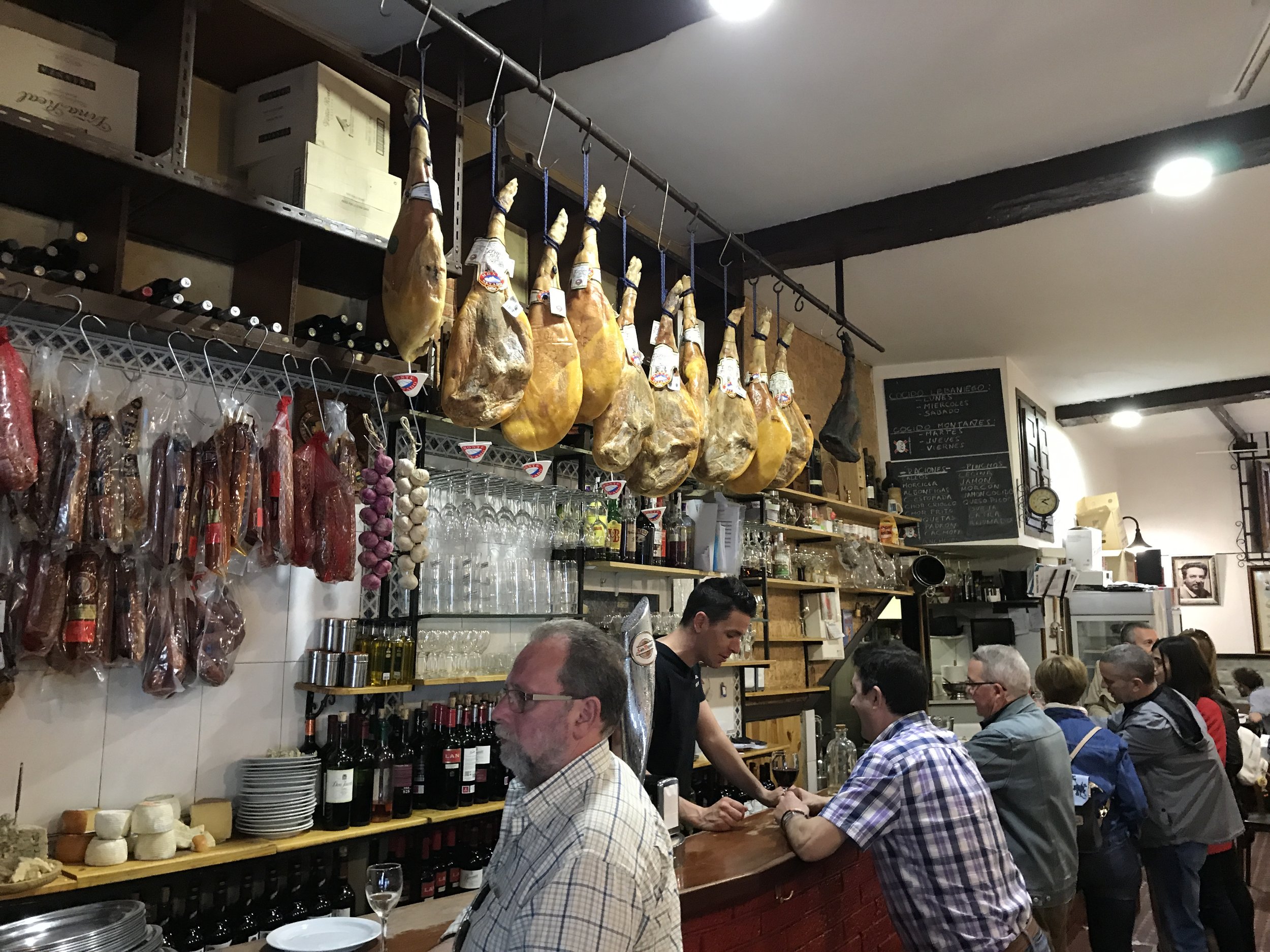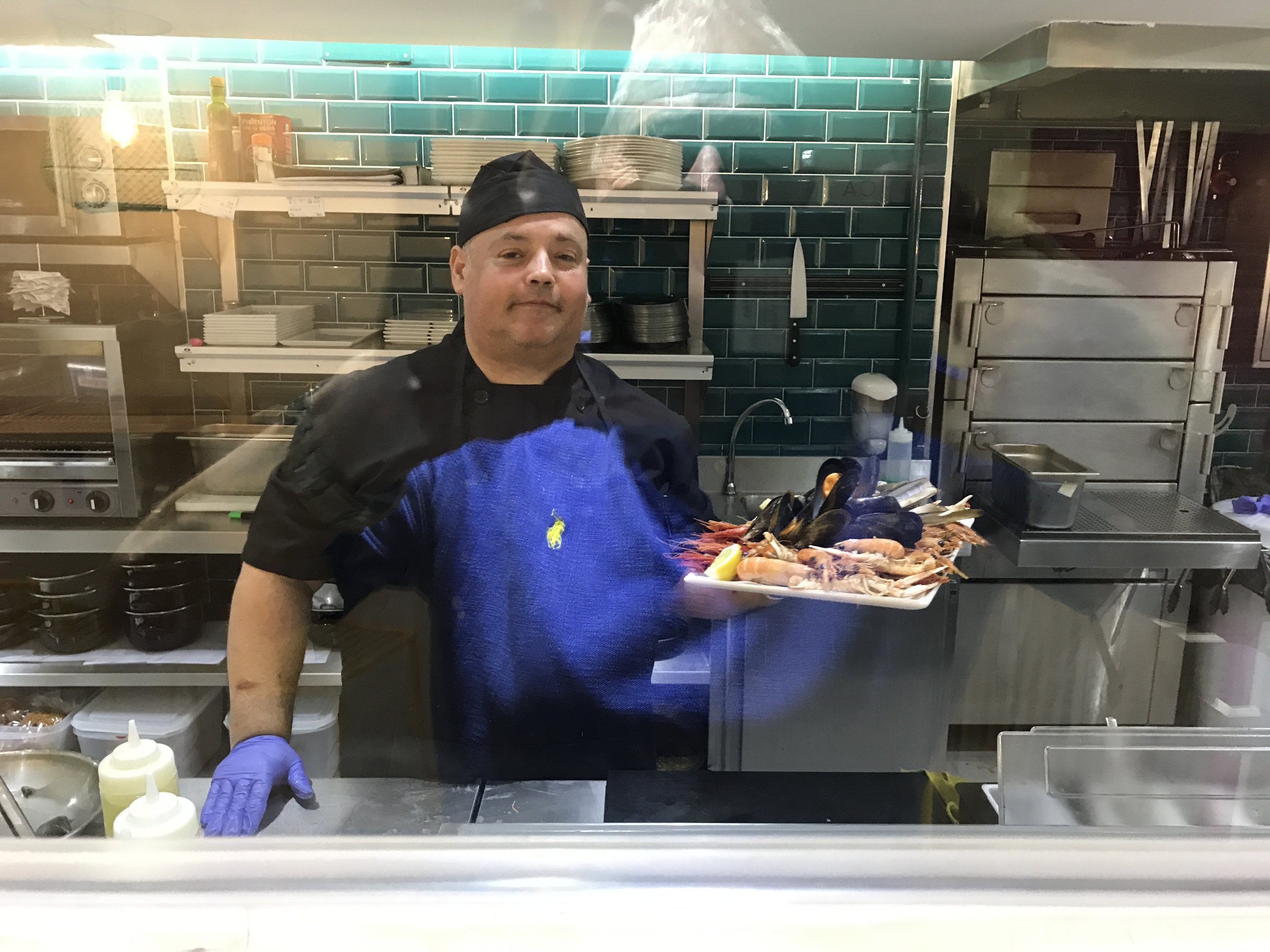Spain 2017
Spain- December, 1983, May-June, 2017
We’ve made four or five trips to Spain and the stories below capture just a few experiences from our first trip, in 1983, when we traveled with our two sons, David and Mike, as well as a more recent trip in May-June, 2017.
December, 1983:
In 1983, the four of us were driving from Malaga to Granada when we came across hundreds of people blocking the highway by lying down in the road. Traffic was backed up for miles and drivers were out of their cars milling around. I asked what was happening and was told the local citizenry were protesting some recent government regulations regarding the public transit system.
There was a young British couple in the car behind us and I told them I was going to get around the problem by taking a dirt road headed up the mountain, which I thought would bring us back to the main road beyond the blockade. They liked the idea and said they’d follow us.
We headed our little car, with baggage piled in the rack on top, up the dirt road and encountered about ten young Spanish men blocking the road with their motorcycles. I went into alert mode and, using my best Spanish, told them my wife was sick and it was important I got her to a doctor. As soon as I saw the guys I told Misti to act sick and not say anything.
The guys bickered among themselves with some saying they didn’t believe my story and others feeling they should let us pass. I guess my Spanish was good enough, and I was able to convince them my story was true, and they finally said “pasa.” I told them our cousins were in the car behind us and they let them through as well.
The experience gave me more confidence in using Spanish as well as my ability to bluff when the going got tough.
May-June, 2017: After traveling for two weeks in France by car, from Paris through the Loire Valley, the southwest (Gascony) and the Pyrenees, we crossed into Spain. This was our fourth trip to Spain, the first thirty-five years ago in 1983, another in 1992, in 2002 and most recently in 2013. We like Spain.
It’s only about thirty miles from St Jean de Luz in France to San Sebastian, also known by its Basque name, Dosastia, a seaside city in the northeastern corner of Spain, on the Bay of Biscay. San Sebastian is a happening place that’s been discovered by the tourist hordes, particularly Europeans and Americans. The old city, parte vieja, teems with small bars and restaurants serving pinchos (pintxos in Basque), small portions of finger food usually eaten with a glass of wine, beer or cider. The city is the most elegant coastal town in Spain, with belle époque mansions lining the waterfront, and La Concha beach stretching more than a mile to the old port.
San Sebastian is the heart of the Basque country and all signs are in Basque first and Spanish second. Basque (euskara) is considered to be the oldest language in Europe, with no known linguistic relatives. It’s spoken by about three-fourths of a million people living mostly in the French western Pyrenees and parts of Northern Spain.
We spent an afternoon at the San Sebastian Aquarium, situated on the harbor and adjacent to old town, with lots of seafood restaurants including Las Rampas, where we had dinner. Connected to the aquarium is the Naval Museum, with replicas of Spain’s merchant and war ships going back to the 1400’s. Looking at the ship models and naval battle exhibits, one can easily recall that in the 16th and 17th centuries Spain had probably the largest navy in the world. Spain’s naval power was diminished when the Invincible Spanish armada was defeated by the British in 1588 off the coast of France. A large part of the museum is dedicated to the fishing and maritime history of Gipuzkoa, which is the official and Basque name of the autonomous province.
Leaving San Sebastian, we drove a short distance to Bilbao for a two-night stay at the Melia Hotel, a few blocks from the Guggenheim Museum. We arrived and checked in just before a French tour group and a large wedding party arrived, so lots of activity at the Melia Hotel and not a word of English to be heard other than the hotel staff.
Bilbao is an attractive city with many parks, bridges that are works of art, a medieval area dating from the 12th century and packed with tapas bars and restaurants, and of course the amazing and world-renowned Guggenheim Museum of Art.
We had always heard good things about the museum and it exceeded our expectations. Our visit was on a Sunday and it was crowded, particularly since Bilbao is now on the cruise ship circuit bringing in lots of American tourists, just for the day. The museum covers a vast area, so nothing ever seems crowded. It was opened in 1997, and is one of the most important architectural accomplishments of the twentieth century. The architect, Frank Gehry, used cutting edge computer technology and titanium, stone and glass to create what is probably one of the most photographed buildings in the world.
Most of the exhibits are of abstract or modern art, much of it American. It was refreshing to be in Europe and see works, displays and films by so many American artists; thank you Solomon Guggenheim Foundation. Peggy Guggenheim’s contribution to American abstract art is in the Peggy Guggenheim Museum in Venice, Italy, a much smaller and more modest structure.
We also visited the Bilbao Museum of Fine Arts, very close to the hotel, and saw a most thought provoking film titled “Different Trains.” The film was made to accompany music written by Steve Reich in 1988 as he imagines how he, as a Jew, would have traveled on very different trains in Europe during WWII to concentration camps, as compared with train travel at the same time period in the US. It’s a powerful presentation and can probably be found on Youtube.
After two days in Bilbao, we headed west to visit friends living in Santander; Jorge, who our son David lived with in Madrid in 1987, his wife Vero, and their three children. They live in a lovely house in a suburb a few miles outside of Santander. Jorge and Vero treated us like royalty, with wonderful dinners, or lunches, since in the Spanish manner they began at three pm and lasted for many hours.
The first afternoon/evening we had a wonderful meat and sausage stew, perhaps the best I’ve ever eaten, and the next day paella, all of course accompanied by excellent Spanish Rioja red wine. Several of their friends joined making for lively conversation in a mixture of both Spanish and English. Nice to be shown around by friends, makes you feel like you live there rather than being a tourist.
Santander is a gem of a city, located in the province of Cantabria, in northwestern Spain, on the Bay of Santander, the largest estuary on the north coast of Spain, opening to the Atlantic Ocean. It has an oceanic temperature, much like San Francisco, resulting in moderate temperatures year round. Its El Sardinero Beach attracts locals from Madrid escaping the summer heat, but the area doesn’t seem to attract the tourist hordes, as do San Sebastian and Bilbao.
We only had eight days left before heading home from Madrid, so with Jorge and Vero’s help we decided which Spanish cities we’d visit. On several previous trips to Spain, we had explored the south, the east, Barcelona, the northwest and Galicia, but we hadn’t spent much time in the Castile/Leon region, in the center of the country. We decided on one night in Burgos, two in Salamanca, two in Segovia and our last three nights in Madrid.
Using Hotels.com, we chose the Mason del Cid Hotel in Burgos and got a room facing the Cathedral with perhaps the best view in the city, for $85. Because of the ancient city’s winding streets, finding the hotel wasn’t easy, with both the car’s GPS and Google Maps giving us conflicting directions. The garage to park the car was a challenge, with security doors opening and closing as we tried to maneuver down the narrow driveways, but such is life in these medieval cities, not built to accommodate modern automobiles, especially one as large as our Renault SUV.
The Cathedral de Santa Maria of Burgos is amazing. Its construction began in 1221 with major changes in the 15th and 16th centuries. It’s of French Gothic design and is the only cathedral in Spain to be independently declared a World Heritage Site. It contains the tomb of El Cid (“the leader”), an 11th century Spanish military commander who reputedly liberated Spain from the Moors and is Spain’s first national hero.
Burgos, known for its intact medieval architecture, was the capital of the Spanish province of Castile, which in 1984 merged with eight other Spanish provinces, and is now an autonomous region called Castile and Leon. Castile and Leon contain the largest number of World Heritage Sites (eight) in the entire world.
Spain is divided into seventeen autonomous regions, comprising a total of fifty provinces. In most cases, the province takes the name of the major city within the province (e.g., Madrid). In 2017 the population of Spain was about forty seven million.
Burgos is an important stopover on the Camino de Santiago, or Pilgrim (Peregrino in Spanish) trail, which thousands of people take every year. It’s also known as the Way of Saint James, and is the route that leads to Santiago de Compostela, where the apostle Saint James is said to be buried. While walking the streets of Burgos you can see many peregrinos, of all ages, with their walking sticks and backpacks.
Our next destination was Salamanca, about a three hour drive from Burgos, mostly on a new four lane divided highway. Spain’s highways, or autopistas, are superb. Many are new, they connect all major cities and there is usually very little traffic. At first we didn’t understand how Spain could afford such roads, but later learned that, like in Greece, much of the funding was from the EU.
Salamanca is a much larger city than Burgos, with lots of tourists and countless hotels and restaurants. Its Plaza Mayor is the second largest in Spain, next to Madrid. Salamanca is a university town, and the Plaza Mayor was filled with college kids drinking, singing, dancing and enjoying life, as the Spanish know how to. The university is the oldest in Spain, dating back to the 11th century, and attracts students from all over the world.
The city dates back to the 3rd century BC and was part of the Roman Empire until it was conquered and occupied by the Moors until the 11th century. Salamanca is filled with beautiful historic buildings, dating back to the middle ages, many of which are of sandstone construction and glow in the sunlight. At night the city is a work of art with the buildings backlit by floodlights.
Misti, the Queen of Hotels.com, booked us a five star hotel with an upgraded room, at a reasonable price and not far from the Plaza Mayor. One interesting aside is the number of Chinese tourists that we hadn’t seen elsewhere. Large tour groups throughout the city, especially around the Plaza Mayor.
After two nights in Salamanca, we drove several hours to Segovia, another medieval city, renowned for its old town center and Roman aqueduct, both of which have been designated World Heritage sites. It’s set on a hillside with views toward the hills of Castilla and the Sierra de Guadarrama mountains. Segovia is considerably smaller that either Salamanca or Burgos, with a delightful Plaza Mayor and many fewer tourists. The name Segovia may also evoke memories of the famous classical guitarist, Andres Segovia, who was not from the city of Segovia.
Our first night in Segovia, after our evening martinis (see description of martinis below), we had dinner at Jose Maria, famous for its regional specialties of roast suckling pig and roast lamb. A very busy restaurant that is empty at 8:30 pm when it opens, but fills quickly as people pour in around 10 pm. We shared a dish of roast suckling pig, not the first time we’ve had this, quite tasty, but not an everyday dish. As they say, a little bit goes a long way.
On our second day we visited the Alcazar, a castle dating from the 12th century, known as being the model used for creating Disneyland’s Sleeping Beauty castle. We also visited the Roman Aqueduct which encircles a large part of Segovia, and is one of the best preserved Roman aqueducts in the world.
Restaurants in Spain are considerably less expensive than in the San Francisco Bay area. The difference in cost is primarily the wine. Good wine is very inexpensive, in fact, a bottle of excellent wine often costs no more than a glass of a similar wine at home.
In Santander, our friend Jorge told us that a common mid-day or before dinner drink is martini. At first we thought he meant a martini as we know it, gin and vermouth. Not so: in Spain it’s simply Martini brand vermouth, often red, over ice with a lemon or orange slice. Very refreshing, not nearly the impact of a gin martini, and it became our go-to pre-dinner cocktail.
We saved the best for last: Madrid. A short drive from Segovia brought us to Spain’s capital city for our last three days. We made the mistake of saying we’d return the car, which we rented in Paris, to Plaza Espana in the heart of downtown Madrid, and arrived around noon to see tens of thousands of people crowding the streets, no sign of Europcar and the GPS completely lost. So we used our “taxi navigation” trick, drove to a taxi stand and told the driver we’d follow him to Europcar, and pay him. That worked fine, and ten euro saved us a lot of agony.
We had booked the Atlantico Hotel on Gran Via, the “Broadway” of Spain, and one of the busiest streets in all of Europe. The receptionist was impressed that I was a gringo with decent Spanish, and he gave us a large room on a high floor with a balcony overlooking the Gran Via (room 708). The nicest room on the trip and a nice way to finish our hotel stays.
With the rental car returned in perfect condition, after more than 4,000 kilometers of driving from Paris, we relied on taxis to get around. Taxis are abundant, cheap and can be hailed on the street, unlike many smaller cities in Spain where you have to go to a taxi stand.
This was our third time in Madrid, the first thirty-five years ago and the second fifteen years ago. On our first visit in 1983, we were younger and less well travelled, and marveled at everything we saw; the Prado, Royal Palace, Plaza Mayor and so on. That was only eight years after Franco died, in 1975, and Spain was still recovering from its fascist period, and Madrid had few tourists. Then it was very inexpensive and seemed darker and more mysterious. The world has since discovered Spain and Madrid.
Our first night in Madrid we went to the Mercado de San Miguel, near the Plaza Mayor, and bellied-up to several tapas counters crowded with locals for wine and tapas. Then we wandered the streets surrounding the Plaza, with restaurants every few feet, decided on seafood, and had a huge platter of mariscos (shellfish) with several glasses of wine, all for about forty euro; the same meal in France was one hundred euro. We finished dinner at eleven, about right for Madrid.
The next day we spent several hours in the Prado Museum, which contains the world’s largest and best collection of Spanish art and is considered one of the greatest art museums in the world. We had dinner at Botin restaurant, founded in 1725, and according to Guinness the oldest restaurant in the world. We had eaten there thirty-five years ago, it’s still excellent and a roast lamb dinner with salad and a bottle of Rioja reserva was half the cost of what we’d pay at home.
On our third day in Madrid the weather turned hot, 90’s, and it wasn’t very comfortable walking. We spent the afternoon in the Reina Sofia Museum, which has the largest collection of Picasso paintings, including a special exhibit of his Guernica, which he painted in 1937, after the Germans bombed that Basque city. Franco had asked Hitler to use Guernica to test the Nazi’s new war planes, and it was the first bombing of a civilian population, with massive destruction and casualties, and led the way for bombings to follow in WWII.
That ended our trip to Spain. A very nice two weeks with lots of great experiences.
Art Faibisch, July 8, 2017





















































































































